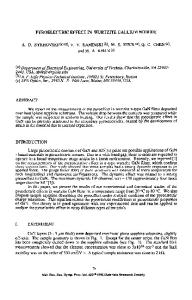Stress Gradients In Heteroepitaxial Gallium Nitride Films
- PDF / 1,669,279 Bytes
- 6 Pages / 414.72 x 648 pts Page_size
- 69 Downloads / 347 Views
GALLIUM NITRIDE FILMS
J. W. AGER IIJ *',G. CONTI *, L. T. ROMANO **, AND C. KISIELOWSKI ***" *Materials Sciences Division, Lawrence Berkeley National Laboratory, Berkeley, CA 94720 **Xerox PARC, 3333 Coyote Hill Rd., Palo Alto, CA 94306 ***Materials Sciences and Mineral Engineering Department, University of California at Berkeley, Berkeley, CA 94720 ABSTRACT Heteroepitaxial GaN films grown on sapphire are usually in a compressive residual biaxial stress state that is typically 100 - 500 MPa but can be as high as 1 GPa. Spatially resolved measurements of GaN film stresses obtained via micro-Raman spectroscopy using shifts in the frequency of the E2 phonon are presented. The spatial resolution of this stress measurement technique is ca. 2 j.xm laterally and 10 •tm in the axial (growth) direction. Two interesting stress gradients are found near cleaved edges. (1) On the surface of the cleaved edge the compressive film stress is a maximum at the GaN/sapphire interface and relaxes to a nearly stress-free state towards the free edge. (2) In the lateral direction, the stress increases away from the edge, reaching a steady-state value at approximately 10x the film thickness. It is shown that the effects are consistent with existing finite element models used to treat strained growth of surface structures in other semiconductor systems. An axial stress gradient that is not associated with edge effects is found in some thick (>20 •tm) HVPEgrown films. The interface region is found to be up to 500 MPa in compression, but this stress declines toward the film surface, which is found to be nearly stress free. INTRODUCTION There is considerable interest in the heteroepitaxial growth and characterization of GaN films on sapphire substrates. Control of film stress is an important issue for film growers [1 ]. Due to the larger thermal expansion coefficient of sapphire compared to GaN, the heteroepitaxial layer is usually in compression. The relationship between the growth conditions and the final film stress state is not completely understood. For example, there are reports that Si-doping can lead to increased compressive stress and a greater propensity for film cracking [2]. Measuring the stress-induced shifts of phonon lines obtained via microRaman spectroscopy is an established technique for measuring stress in semiconductor systems with high spatial resolution [3]. We apply this technique to GaN and measure stress with spatial resolution on the micron scale in both lateral and axial (growth) directions. The results are compared to finite element (FEM) models developed for other semiconductor heteroepitaxy systems. EXPERIMENTAL GaN films ranging in thickness from 1 to 70 microns were grown by hydride vapor phase epitaxy (HVPE) [4]. Films ranging in thickness from 1 to 5 microns were grown by metal organic chemical vapor deposition (MOCVD). Raman spectra of the GaN layers were obtained using a Ramnan microprobe equipped with a 100x (NA 0.95) objective and a 769 Mat. Res. Soc. Symp. Proc. Vol. 482 © 1998 Materials Research Society
Data Loading...










